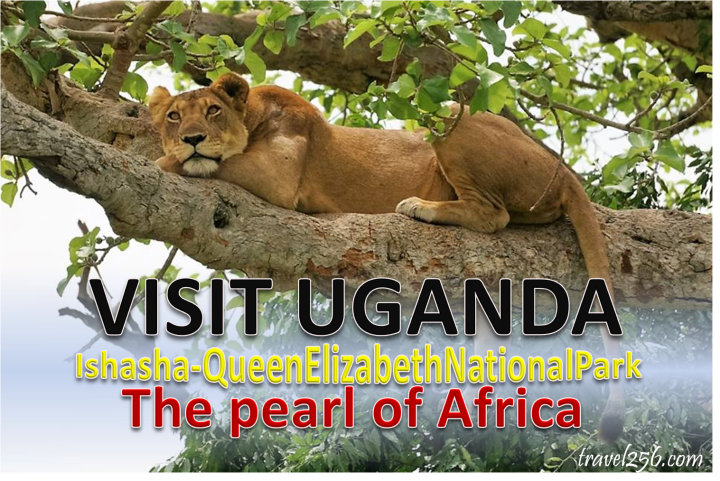
August 10th is a day for people to come together from across the world to pay tribute to the mighty lion in as many ways as possible. Though a fun and exciting occasion for all, its foundations are based in a very serious matter: lion numbers have dramatically declined to the point where the species needs to be placed on the endangered list, just like its larger cousin the tiger. Uganda offers a tremendous opportunity to see the Panthera Leo in various conservation areas that will make your wildlife safari in Uganda a memorable one with lifetime memories. At Travel 256 we provide safari car rentals for self drive or guided tours to enable you explore all the amazing places of Uganda.
Facts About A Lion-Panthera leo | Tree Climbing lions in Uganda-Ishasha
Living in the grasslands, scrub, and open woodlands of sub-Saharan Africa, the lion is the second largest cat in the world. It is dwarfed slightly by the tiger, which is closely related and has a very similar body type.
Unlike other cats, lions are very social animals. They live in groups, called prides, of around 30 lions. A pride consists of up to three males, a dozen related females, and their young. The size of the pride is determined by the availability of food and water. If resources are scarce, the pride becomes smaller.
Pride members keep track of one another by roaring. Both males and females have a very powerful roar that can be heard up to 8 km (5 mi.) away.
Males and females take on very different roles in the pride. Male lions spend their time guarding their territory and their cubs. They maintain the boundaries of their territory, which can be as large as 260 sq. km (100 sq. mi.), by roaring, marking it with urine, and chasing off intruders. Their thick manes, a unique trait to male lions, protect their necks when they fight with challengers.
Female lions are the primary hunters of the group. They are smaller and more agile than males. But since their prey is still generally faster than them, they use teamwork to bring an animal down. Fanning out, they form a semicircle, with the smaller, weaker lionesses herding the prey towards the center. Then the stronger females knock the animal down and make the kill.
Lions usually hunt at night. Their prey includes antelopes, buffaloes, zebras, young elephants, rhinos, hippos, wild hogs, crocodiles and giraffes. But they also sometimes eat smaller prey like mice, birds, hares, lizards, and tortoises. They are not above stealing kills from other carnivores, like hyenas, wild dogs, cheetahs, and leopards, or scavenging spoiled meat.
After a successful hunt, all the lions in the pride share the meal. But there is a pecking order, with the adult males taking first claim, followed by the lionesses, and finally, the cubs.
Lions have a fast-working digestive system, which allows them to gorge themselves and then go for seconds shortly after. If available, they will drink water everyday. But they can go 4-5 days without drinking by obtaining moisture from the stomach contents of their prey.
Spending 16-20 hours of the day sleeping or resting, lions are the laziest of the big cats. They can be found lying on their backs with their feet up or taking a snooze up in a tree. While lazing around, they are very affectionate towards one another, rubbing heads, grooming, and purring.
Lionesses give birth to 2-3 cubs at a time. Usually a couple females give birth around the same time. The cubs are then raised together, sometimes nursing communally.
Vulnerable to predators like hyenas, leopards, and black-backed jackals, cubs have a 60-70% mortality rate. They are sometimes trampled by large animals like buffaloes. Furthermore, when another group of male lions takes over a pride, they kill all the cubs so they can sire their own with the lionesses.
Female cubs stay with the group as they age. At around two years old, they become capable hunters. But young males are forced out of the pride at that age. They form bachelor groups and follow migrating herds until they are strong enough to challenge male lions of other prides. In general, a group of males stays in power in the pride for around three years before another bachelor group takes it over.
Conservation Status
African lions are considered vulnerable of extinction by the IUCN Red List. They are threatened by loss and fragmentation of habitat. They are also killed by humans in bravery rituals, as hunting trophies, for medicinal powers, or by ranchers protecting their livestock. Furthermore, they are susceptible to tick-borne diseases like canine distemper and babesia. Distemper is spread to lions by neighboring village dogs as well as hyenas. Babesia occurs during droughts, when malnourished prey is vulnerable to disease. The ticks spread to the lions after they kill the sick animal. The combination of distemper and babesia causes mass fatalities in lion populations.
What You Can Do to Help
You can help save lions by visiting any conservation area and for those who would wish to see the tree climbing lions, Uganda offers a great opportunity in the Ishasha area of Queen Elizabeth National Park in south western Uganda. Other places where you can see lions in Uganda include Kidepo Valley National Park in north eastern Uganda, Murchison Falls National park in north western Uganda and at the Uganda Wildlife Education Centre (UWEC) also known as the National Zoo in Entebbe.
For more information or to book a safari in Uganda, contact us today via info@travel256.com or call our travel consultant on +256-701367970.